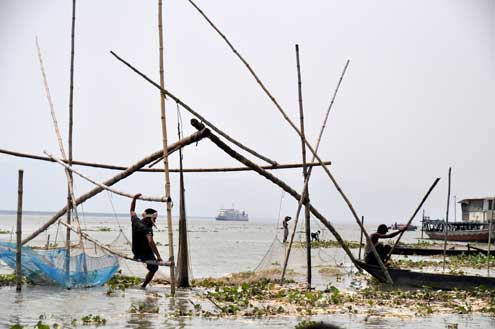Images of the major rivers of Asia – including the mighty Mekong that snakes through Southeast Asia and the Ganges and other revered rivers that bisect the subcontinent – might seem at odds with the sobering fact that Asia is the world’s driest and most water-stressed continent. Climate change, combined with rapid population growth and urbanization, are placing intense pressure on Asia’s most precious resource. At the same time, extreme weather has led to unprecedented monsoon rains and deadly floods across the region that have eaten away at traditional livelihoods and in some cases interrupted the entire global supply chain for certain industries that are located in flood-prone regions. How governments, civil society, and citizens work together to address these issues will shape Asia’s development trajectory. This photo blog looks at some of these concerns across the region. Compiled by In Asia editor Alma Freeman.
South Asia is home to three of the most densely populated river basins in the world – the Indus, Ganges, and Brahmaputra – which support an estimated 700 million people. The basins straddle national borders, making them a natural source of contention between neighboring countries. Photo/Flickr user Scott Anderson

In the next 40 years, the urban population in Asia will almost double from 1.6 billion to 3.1 billion. As a result, Asia’s cities are struggling to meet already strained demand for clean water. According to the WHO, in India alone more than 97 million people lack access to safe drinking water. Photo/Geoffrey Hiller

Changing weather patterns as a result of climate change and other factors have resulted in unprecedented monsoon rains and deadly floods. Encroaching development on flood plains worsens the effects of flooding in places like Delhi. A pump draws water from the Yamuna River in Delhi to be used for irrigation on the Sarai Kale Khan flood plain. Each year the area is regularly flooded during the monsoon season. Photo/Conor Ashleigh

From July 2011 to January 2012, Thailand experienced the worst flooding in five decades. Heavy monsoon rains submerged one-third of the country, left nearly 700 dead, and led to millions of dollars in economic loss from major industries as flood waters ground production to a halt in electronics, auto factories, and other industries. Photo/Mr. Weerapon Sripongchai, senior project associate, Disaster Risk Management Systems, Asia Disaster Preparedness Center (ADPC)

The enormity of the crisis exposed the realities of Thailand’s still nascent model for responding to natural disasters. Many agree that what was missing from the country’s emergency flood response and relief agenda was a clear, consistent source of flood information and a communication system to backstop emergency response and recovery efforts. Photo/Flickr user ILO

According to a report authored by UN climate scientists, coastal areas in Asia will be among the worst affected by climate change. The negative effects of sea level rise and extreme weather is already evident in the southern coastal areas of Bangladesh near Khulna, where erosion and cyclones have already displaced thousands of residents. Photo/Conor Ashleigh

In addition to displacement of residents, Bangladesh’s low-lying coastal areas are faced with increasing salt-water intrusion, which has led to serious health concerns and loss of livelihood for households that traditionally rely on agriculture and fisheries. Photo/Conor Ashleigh

One of Asia’s most sparsely populated countries, Mongolia, suffers from severe water scarcity despite having some of the largest freshwater lakes in the region. Water sources are unevenly distributed within the landlocked nation with abundant surface water resources located in northern Mongolia, which are inaccessible for the drier central and southern parts of the country that lack water sources. Photo/Jon Jamieson

A new report from the Asian Development Bank warned that its growing capital, Ulaanbaatar, home to nearly half of the population, will face water shortage as early as 2015. Photo/Kristin Kelly Colombano

Apart from water scarcity, water quality is also a worrying concern in Mongolia with herding, mining, and urban development posing threats to public health.
Source: AsiaFoundation










